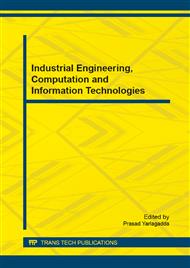[1]
Pei-Yin Chen, and Chih-Yuan Lien, An Efficient Edge-Preserving Algorithm for Removal of Salt-and-Pepper Noise, IEEE signal processing letters, Vol. 15, pp.833-836 , (2008).
DOI: 10.1109/lsp.2008.2005047
Google Scholar
[2]
Haidi Ibrahim, Nicholas Sia Pik Kong, and Theam Foo Ng, Simple Adaptive Median Filter for the Removal of Impulse Noise from Highly Corrupted Images, IEEE Transactions on Consumer Electronics, Vol. 54, No. 4, pp.1920-1927 , Nov. (2008).
DOI: 10.1109/tce.2008.4711254
Google Scholar
[3]
How-Lung Eng, and Kai-Kuang Ma, Noise Adaptive Soft-Switching Median Filter, IEEE Transactions On Image Processing, Vol. 10, No. 2, pp.242-251, February (2001).
DOI: 10.1109/83.902289
Google Scholar
[4]
Pei-Eng Ng and Kai-Kuang Ma, A switching median filter with boundary discriminative noise detection for extremely corrupted images, IEEE Trans. on Image Progressing, Vol. 15, No. 6, pp.1506-1516, June (2006).
DOI: 10.1109/tip.2005.871129
Google Scholar
[5]
Naif Alajlan, Mohamed Kamel and Ed Jernigan, Detail preserving impulsive noise removal, Signal processing: image communication, Vol. 19, Issue 10, pages: 993-1003, (2004).
DOI: 10.1016/j.image.2004.08.003
Google Scholar
[6]
WANG Xiong-Liang, WANG Chun-Ling,ZHU Ju-Bo , LIANG Dian-Nong,Salt-and-Pepper Noise Removal Based on Image Sparse Representation,Optical Engineering , 2011, 50(9)097007:1-7.
DOI: 10.1117/1.3625416
Google Scholar
[7]
Ram, M. Elad and I. Cohen, Image Processing using Smooth Ordering of its Patches, IEEE Trans. on Image Processing, Vol. 22, No. 7, Pages: 2764-2774, July (2013).
DOI: 10.1109/tip.2013.2257813
Google Scholar
[8]
Ram, M. Elad, and I. Cohen, Patch-Ordering-Based Wavelet Frame and Its Use in Inverse Problems, IEEE Transactions on Image Processing, Vol. 23 No. 7, Pages 2779-2792, July (2014).
DOI: 10.1109/tip.2014.2319739
Google Scholar
[9]
Michael Elad, Sparse and Redundant Representations,Springer, (2010).
Google Scholar
[10]
M. Elad, Sparse and Redundant Representation Modeling — What Next?, IEEE Signal Processing Letters, Vol. 19, No. 12, Pages 922-928, December (2012).
DOI: 10.1109/lsp.2012.2224655
Google Scholar
[11]
Wang Z., Bovik AC, Sheikh HR, Simoncelli EP, Image quality assessment: From error visibility to structural similarity, IEEE transactions on image processing, Vol. 13, No. 4, pp.600-612, (2004).
DOI: 10.1109/tip.2003.819861
Google Scholar
[12]
Wang Z., The SSIM Index for Image Quality Assessment, http: /www. cns. nyu. edu/~lcv/ssim.
Google Scholar


